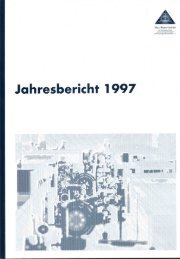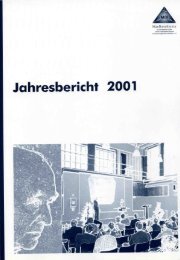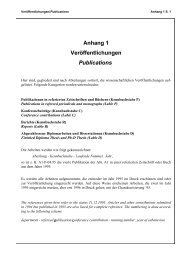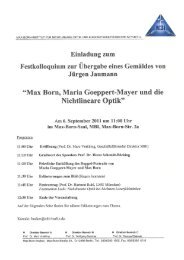Create successful ePaper yourself
Turn your PDF publications into a flip-book with our unique Google optimized e-Paper software.
X-ray machine? The answer is yes! Here is how it is done. As we have already discussed, a<br />
low-frequency laser pulse moves the molecule’s electrons in the same way that water moves<br />
as a glass is tipped. The electrons would move further if the glass walls (the Coulomb attraction<br />
between the electrons and ions) would allow it. (In other words, the electrons apply a<br />
force on the ions just as the ions apply a force on the electron.) The force includes a torque<br />
(twist) on the molecule [11, 12]. The molecule responds to the torque much as a pendulum<br />
responds to gravity: that is, the molecule rotates to minimize its potential energy. Like a pendulum,<br />
all small-angle molecules pass through a period of alignment. At this particular time,<br />
we have aligned the molecule in space much as we align a patient.<br />
However, our “molecular patient” cannot remain still. Therefore, we must catch our image “on<br />
the fly.” This is not as hard as it sounds for two reasons. First, our lasers have pulses that are<br />
short enough to “freeze” almost any motion. Second, quantum mechanics forces the molecule<br />
to pass through periods of alignment at regular and predictable intervals.<br />
Figure 12 outlines the experiment [13]. We use one optical pulse (the pump or alignment<br />
pulse) to start the molecule rotating, and a second pulse (the probe or HHG pulse) to generate<br />
high-harmonic radiation when the molecule is transiently aligned. This harmonic spectrum is<br />
the information that we need to image the orbital. The illustration shows the two laser beams<br />
focussed into the molecular jet and the harmonic beam (in blue) being dispersed in a spectrograph.<br />
The lower image shows the harmonic spectrum obtained from nitrogen molecules that<br />
are aligned parallel to the electric field of the pulse that generates the harmonics.<br />
In my lab, we use N 2 molecules. A set of spectra obtained for 19 different projections of the<br />
highest occupied molecular orbital (a one-electron approximation of the multi-electron wave<br />
function). These spectra contain all of the information that we need for an image – with the<br />
exception of one detail – we need to know how bright the re-collision electron is at any given<br />
energy. We use an argon atom for this purpose. Argon has the same ionization potential as N 2<br />
and ionizes almost identically. Comparing the harmonic spectra from argon and N 2, we calibrate<br />
the strength of the re-collision electron. Figure 13 shows 5 of the 19 calibrated spectra.<br />
The calibrated spectra in Fig. 13 are the input needed to produce a tomographic image of an<br />
orbital. The lower frame in Fig. 14 shows the orbital for N 2 that we obtain using the tomographic<br />
re-construction procedure. This image is compared with the “Highest Occupied Molecular<br />
Orbital” (HOMO) of N 2 shown in the lower frame.<br />
Fig. 10<br />
Three-dimensional depiction<br />
of the interference<br />
The electron image<br />
<strong>Max</strong> <strong>Born</strong> • Paul Corkum 41












